
How To Grow Hot Peppers Outdoors
There's nothing quite like having your own supply of spicy hot peppers. And while it may seem a daunting task to grow them outdoors, we're here to show that it's really not! All you need to do is follow our handy guide, and you'll have a harvest of great-tasting hot peppers before you know it. What are you waiting for?
There's no question about it; growing your own hot peppers is a hugely rewarding experience. From germination to harvest, there are numerous steps involved in raising a successful and fruitful plant. While it may sound like a tall order, it really needn’t be. In fact, we're here to guide you through every step of growing hot peppers outdoors. So no matter your expertise on cultivating chillies, we're confident we've got the tips to help you achieve a successful outdoor haul, time and time again.
Why grow hot peppers outdoors?
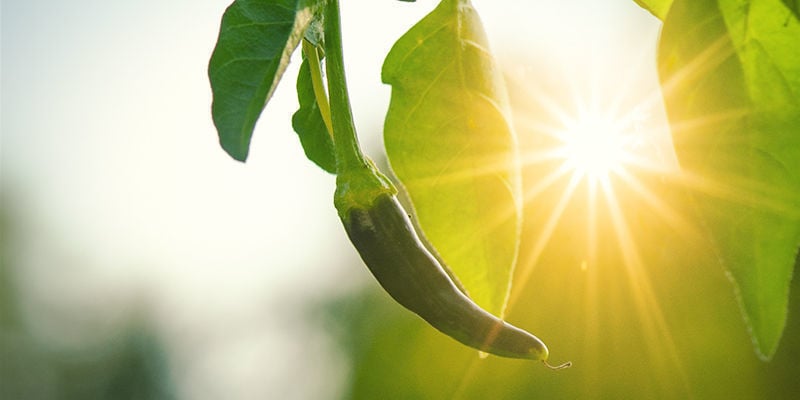
It's a simple question, but why should you bother to grow peppers outdoors when you can do so under controlled conditions indoors? Well, it's no secret that plants flourish under the open sun, so if you've got space to house a plant (or several), make the most of it and cultivate peppers outside.
Of course, outdoors, plants are subject to a great deal of light and warmth that won't cost you anything. In comparison, peppers grown indoors will need artificial light and perhaps a heat mat, which may set you back a bit.
Moreover, depending on where you live, you may find that the soil in a flowerbed is suitable enough for growing hot peppers, so you'll undoubtedly save yourself money by not needing to procure containers and compost. Be sure to test the soil first and make sure it's ideal, and you'll be onto a winner.
Additionally, potentially unlimited vertical space outdoors will allow you to grow taller Capsicum plants with no height restrictions. So if room is a concern for you, growing outdoors is the best solution. That dream of having a jungle of pepper plants could soon be a reality!
What do you need to grow hot peppers outdoors?
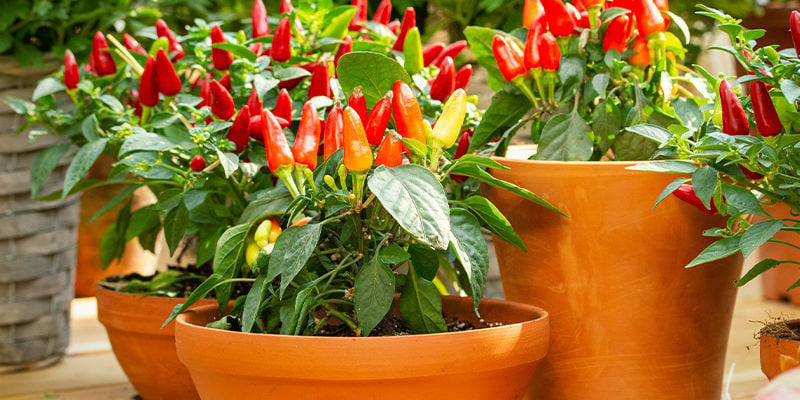
When it comes to growing chillies outdoors, the available space will somewhat dictate the equipment you’ll need. When we think of growing outdoors, we often picture a vast garden space. But in reality, many growers have to make the most of a small patio, a disguised flowerbed, or even a tight balcony space.
If you're looking to grow your plants in containers, ideally you'll need at least two different sizes—a smaller one for getting your plants started indoors (more on that later), and a larger one to transplant into when your seedlings are ready to flourish outside.
If you're planting directly in containers, it's definitely worth picking up some loamy soil; this will retain moisture while also allowing adequate drainage. Pepper plants also respond best to pH levels of between 6.2 and 7.0, so keep that in mind when browsing for suitable soil.
Water and nutrients are of course needed throughout the growing cycle. There are various organic and store-bought plant feeds that can boost the performance of your hot peppers immeasurably, improving the flavour, potency, quality, and quantity of the berries.
As a regular maintenance schedule is required throughout the growing process, you can purchase accessories such as pruning shears to help strip back overbearing leaves and expose your plants to more sunlight and warmth.
While there are a few items needed for a successful pepper growing project, you'll find that all the equipment is reusable, and you may already have most of it lying around the home.
Picking the perfect pepper
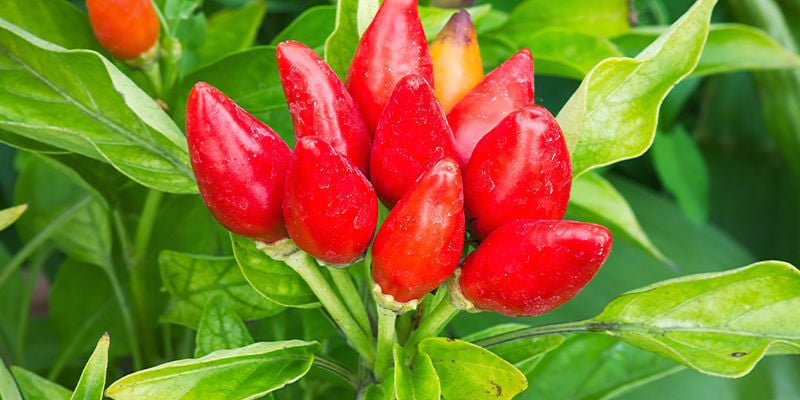
Of course, we'd be remiss not to mention the most essential part of growing hot pepper plants: your choice of seed! With so many to choose from, there are a few decisions to factor in before settling on your perfect pepper. First and foremost, think about your experience as a grower; if you're brand new or have little knowledge or expertise in cultivating peppers, you may want to look for a seed with a short growing cycle that's easier to manage. The jalapeño pepper, for example, is a robust and resilient specimen that can reach maturity in just 75 days after fruit set.
On the other hand, if you have plenty of growing experience, you can choose almost any pepper as long as you have patience and time to see it through.
It is also worth noting the size to which some pepper plants grow. If you have no space restrictions, this may not be relevant. But if you're growing in a smaller outdoor environment, it's worth noting that some pepper plants can easily reach around 1–2 metres in height. So make sure your space has enough room.
Lastly, consider your preferences when it comes to heat. If you prefer your chillies more on the milder side, go for a seed that will produce more palatable berries for you. There's no point in producing super hot peppers that are too spicy to enjoy. So potentially play it a little safer to begin with—you can always turn up the heat on the next set of seeds.
When should you start growing outdoor hot pepper plants?
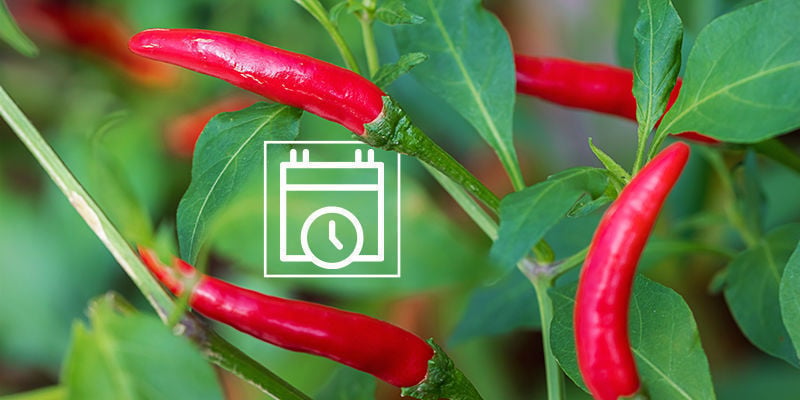
Timing is everything when it comes to growing hot peppers. It will take a little bit of planning, but the key to a successful outdoor grow is making the most of the warmth and light of the growing season.
With this in mind, plants should be ready to flourish outdoors over the summer months. That doesn't mean you can't make the most of the preceding weeks, as plants can be started indoors and then moved outside to really take advantage of the changing of the seasons.
Ideal conditions for growing hot pepper plants outdoors
So, what is the ideal setting for cultivating pepper plants outside? Plants need around 6–8 hours of sunlight a day to flourish, so be sure to plant them in a location where they'll receive plenty of unobstructed light. While it's true that peppers flourish more in Mediterranean climates (or similar), that's not to say those living in more temperate conditions can't also produce a high-quality yield. This is why it's hugely important to prepare your plants in the colder months, and then bring them outdoors to take in all the light and warmth the summer has to offer. You'll be surprised at just how well they can do.
Pepper plants also perform best in loamy soil, so keep this in mind when preparing the bed or container for your plant. Also, test the soil pH level to ensure it's hospitable for your plant. With just a little preparation, you can minimise the margin of error significantly. Just take your time, and you can't go wrong.
How to grow hot peppers outdoors
Now that you've planned out your grow and purchased all of the equipment you'll need, it's time to get down to it. In the following sections, we'll cover everything you need to know to achieve healthy and fruitful hot pepper plants. All that's required is a little attentiveness, care, and patience throughout, and you'll be rewarded with a hefty harvest. Ready? Let's go.
Start hot pepper plants indoors
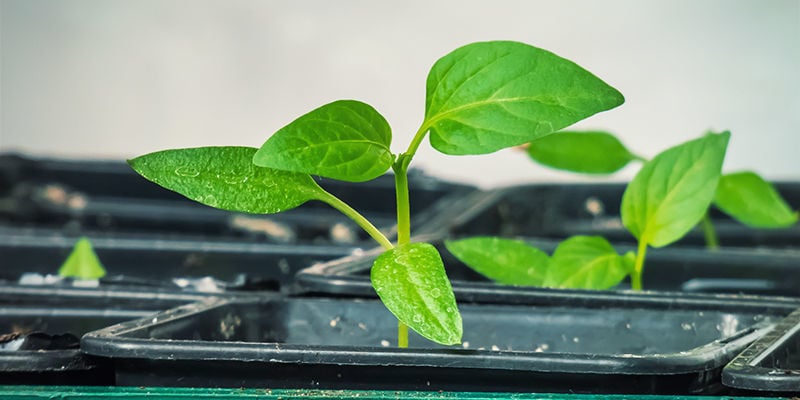
Whether you live in a hot climate or a colder one, your seeds need to be germinated before they can flourish. While there are many different schools of thought regarding this process, arguably the easiest is to germinate indoors. This allows you to keep an eye on your seeds during this crucial stage and control their environment. It also allows you to get them started in the darker, colder months so they're ready to capitalise on the warmer months to come.
When it comes to the actual act of germination, you have a few options. One method is placing seeds in a damp paper towel and allowing them to germinate in a warm location such as an airing cupboard, on top of a fridge, or even on top of a heat mat. The combination of the damp paper towel and heat is enough to provide the ideal environment for the seeds to begin to sprout.
However, many turn to dedicated germination kits such as Smart Start for a much more reliable method. These kits have individual soil-filled pots that provide the optimal setting for seed germination. They still require a heat source, such as a heat mat, but germination kits are a quick and practically effortless way to get your grow started on the right foot.
Another option is sowing seeds directly into the soil in small containers. Once they sprout into seedlings and gain some height and mass, you can eventually transplant into larger containers.
Alternatively, those living in warmer environments can always germinate their seeds in the ground. Regardless, the same rules apply—keep the surrounding soil moist but not flooded, and the sun will provide the warmth the seeds need to sprout.
Harden off your chilli pepper plants
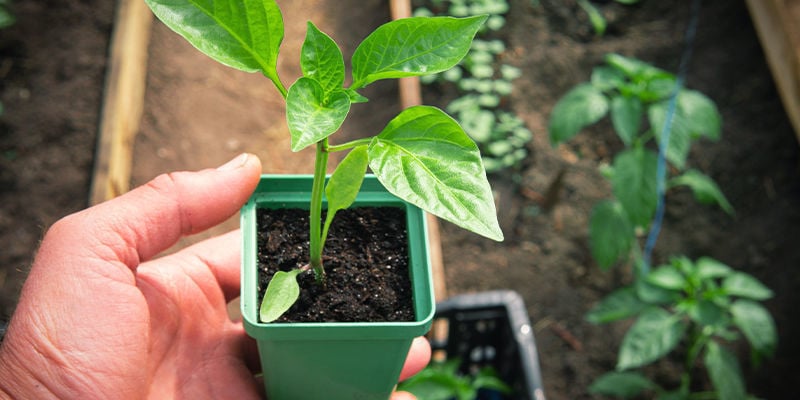
Plants started indoors will no doubt become acclimatised and comfortable in their temperature-controlled environments. However, many find that when it comes time to move them outdoors, they begin to wilt and don't react well to the change in setting. While not uncommon, you can take steps to ensure the transition is as smooth as possible. One such method is “hardening off” your plants.
This essentially involves moving your peppers outside for a few hours per day over the course of around two weeks. During this time, you can slowly increase the length of exposure until your plants become fully acclimated. If possible, start out by placing them in a sheltered area such as a greenhouse or a cold frame. Leave them here for a couple of hours during the first couple days, then bring them back inside. Over the next several days, increase the length of time in 2-hour increments, and you’ll soon see your peppers start to thrive.
It may sound like a simple exercise, but many inexperienced growers neglect this hardening off stage and end up with weak plants that take significantly longer to flourish. So don’t skip this step! Just make sure not to begin the hardening off process until the last frost has passed. You can usually find information on the projected last frost date for your region online. Although you can't be 100% sure, err on the side of caution to avoid any disasters.
Transfer to a garden bed or large container
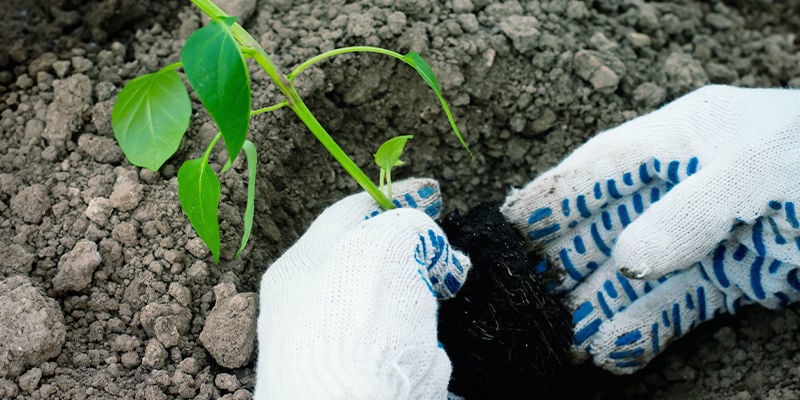
The summer months are fast approaching; you've taken the time to harden your plants, and now it's time for them to truly flourish. This means it’s time to move them to larger containers or a garden bed until harvest. Once your pepper plants have established a good root ball and reached about 20–30cm in height, they're ready to go.
As the plants have been growing in small containers up to this point, you need to be careful when removing the root mass. First loosen the soil around the edges of the pot, and carefully slide the plant and root ball into your hand by tipping the container upside down.
Once removed, simply place it into a larger soil-filled container to house your plant for the remainder of its growing cycle. The same goes for cultivating in a garden bed; make a hole in the soil large enough for your plant, place it inside, and it will flourish in no time at all. If you're growing multiple plants simultaneously, be sure to leave a gap of around 60–90cm between them so they have space to stretch out as they grow.
Water, mulch, and train
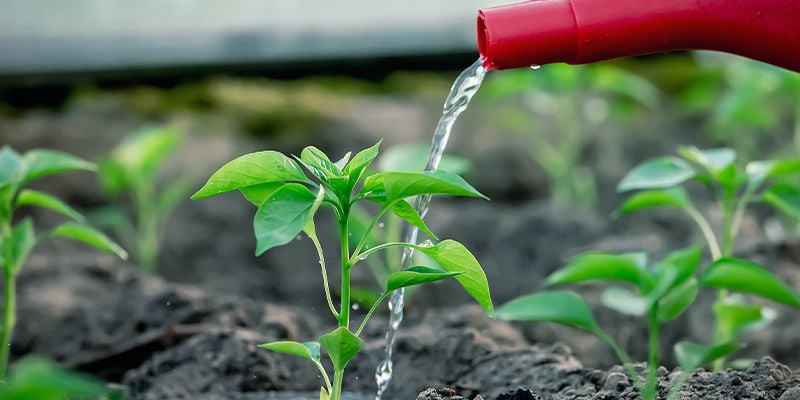
As previously touched upon, following a strict maintenance schedule is of the utmost importance when cultivating pepper plants. When it comes to watering, growers should be vigilant. As a rule of thumb, it's best to water when the soil surrounding the plant feels dry. This could be every 2–3 days in temperate conditions, but those living in warmer climates may need to water their plants daily. However, this is only in scorching environments, so be sure not to overwater, or it could spell disaster.
You can always use mulch to reduce the need for watering, as it helps to retain moisture in the soil. Applying mulch around the base of the plant will successfully keep it from drying out. When it comes to which type of mulch to use, there are plenty of viable biodegradable and non-biodegradable options available online and in stores.
Much like cannabis plants, pepper plants can be trained to perform at their best, potentially increasing the quality and quantity of their yield. For example, as pepper plants can sometimes grow quite bunched up, growers can tie strings to the branches to force them to grow in a particular direction. This allows the entire plant to take on more light, and encourages ramification (branch and stem development). This is just one of many training techniques you can use to get the most out of your pepper plants, so be sure to do your research on all the tried and tested techniques.
Time to harvest
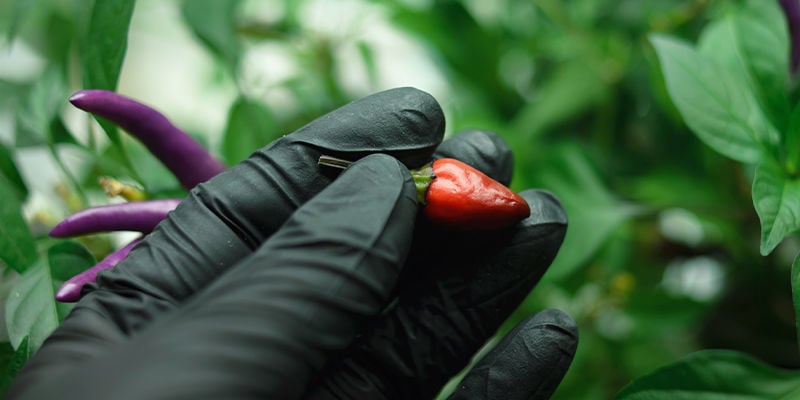
While the harvest time for pepper plants differs among cultivars, it tends to take anywhere between 60–80 days after fruit set before they're ready to pick. There are numerous signs to look out for, depending on the pepper, including reaching a specific size, changing colour (for example, from green to red), and even “corking” (scarring on the skin). Overall, be on the lookout for firm fruits.
When it comes to removing the peppers from the plant, it may be tempting to be a little heavy-handed and pull them from the branch. However, this can cause damage to the plant, so go easy at this crucial stage. To minimise damage, take the pepper in between your fingers and give it a gentle pull against its direction of growth. Normally, ripe peppers will easily come off with little resistance.
Tips for outdoor hot pepper growing
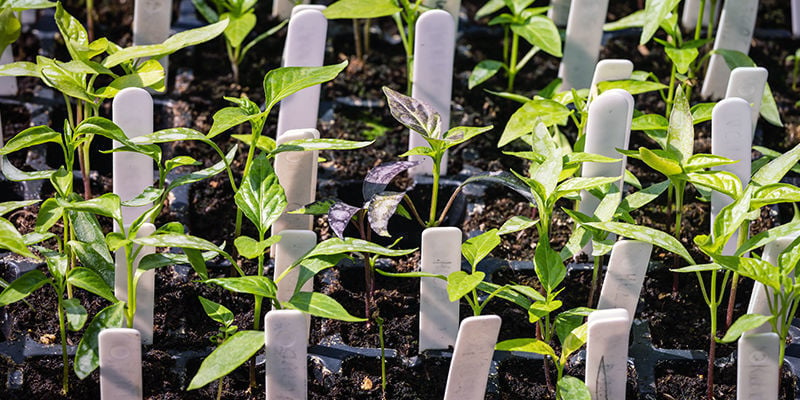
While we’ve covered the key aspects of growing hot peppers outdoors, below we share some helpful tips to further maximise the quality of your results.
Pinch off the first flower
It may seem counterproductive, but pinching off that very first flower that appears will allow your plant to focus its energy on growing bigger, and consequently producing a larger yield.
Label your plants
Be sure to label your plants, especially if you've got multiple cultivars going at the same time. This will allow you to recognise which variety is which, and improve how you monitor and care for them. Include details such as the name of the species and the date you planted it for the sake of ease.
Provide support
Some chilli pepper varieties can grow to pretty tall heights, so it's definitely worth investing in some staking so your plants can continue growing straight. The last thing you need is a plant toppling over due to a lack of support.
Protect your plants
Whether growing in containers or a garden bed, your plants will need protection against all manner of potential problems—namely pests and pets! Pets and other animals can be kept at bay using a repellent. Pests can be avoided by simply keeping an eye on your plants and ensuring ideal conditions in your growing area. You can always use neem oil to deter pests, if appropriate.
So there you have it—a complete guide on cultivating hot peppers outdoors. Whether this is your first foray into the world of growing chillies or you have years of experience, the same rules apply—be patient, be attentive, and most of all, enjoy the fruits of your labour.
-
 7 min
4 March 2022
How To Grow Hot Peppers Indoors
Growing chillies might seem like a complicated task, but we're here to tell you that it really needn't be. Even if you don't have an adequate space outside to grow them, you can produce some...
7 min
4 March 2022
How To Grow Hot Peppers Indoors
Growing chillies might seem like a complicated task, but we're here to tell you that it really needn't be. Even if you don't have an adequate space outside to grow them, you can produce some...
-
 4 min
18 February 2022
Tips For Growing Hotter Chili Pepper Plants
Surely it's down to chance just how hot your chili peppers can be, right? Well, while various factors determine spice level, there are actually several things you can do to really get the hottest...
4 min
18 February 2022
Tips For Growing Hotter Chili Pepper Plants
Surely it's down to chance just how hot your chili peppers can be, right? Well, while various factors determine spice level, there are actually several things you can do to really get the hottest...
-
 4 min
25 January 2022
Best Companion Plants For Chili Peppers
If you love growing hot pepper plants, but want to do more with your outdoor grow, companion plants are an excellent way to diversify your garden and improve the quality of your pepper harvest....
4 min
25 January 2022
Best Companion Plants For Chili Peppers
If you love growing hot pepper plants, but want to do more with your outdoor grow, companion plants are an excellent way to diversify your garden and improve the quality of your pepper harvest....
-
 5 min
24 January 2022
When And How To Harvest Hot Peppers
You've taken the time to cultivate hot peppers, giving them everything they need to flourish throughout their growing cycle. Yet, arguably the most critical moment is fast approaching; when and how...
5 min
24 January 2022
When And How To Harvest Hot Peppers
You've taken the time to cultivate hot peppers, giving them everything they need to flourish throughout their growing cycle. Yet, arguably the most critical moment is fast approaching; when and how...













 United States
United States










